Maya 2012
Primer: Three Maya Calendars
By ZACH ZORICH
Friday, November 30, 2012
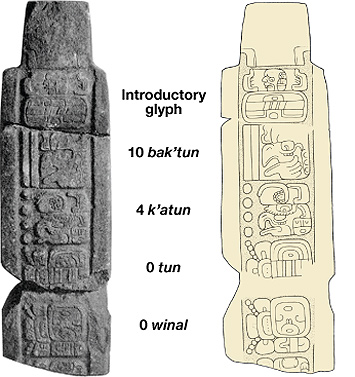 The Maya calendar that records the longest span of time is called the Long Count. It marks the number of days that have passed since a mythological founding date that fell on either August 11 or 13, 3114 B.C., depending on how the Maya calendar is reconciled with our calendar. Long Count dates are usually written as a series of five numbers, such as 7.17.18.13.3 (the date that corresponds to January 1, A.D. 1). The smallest unit of time is the day, or k’in, and it is recorded in the place farthest to the right. The next place records the number of winals, a 20-day unit of time often referred to as a “Maya month.” The third place records the number of Maya years called tuns. Eighteen winals make up a tun, for a total of 360 days. The Maya extended the count by multiplying each successive cycle by 20. Thus, 20 tuns make up a k’atun, and 20 k’atuns make up a bak’tun—a period of time equivalent to 394.52 solar years.
The Maya calendar that records the longest span of time is called the Long Count. It marks the number of days that have passed since a mythological founding date that fell on either August 11 or 13, 3114 B.C., depending on how the Maya calendar is reconciled with our calendar. Long Count dates are usually written as a series of five numbers, such as 7.17.18.13.3 (the date that corresponds to January 1, A.D. 1). The smallest unit of time is the day, or k’in, and it is recorded in the place farthest to the right. The next place records the number of winals, a 20-day unit of time often referred to as a “Maya month.” The third place records the number of Maya years called tuns. Eighteen winals make up a tun, for a total of 360 days. The Maya extended the count by multiplying each successive cycle by 20. Thus, 20 tuns make up a k’atun, and 20 k’atuns make up a bak’tun—a period of time equivalent to 394.52 solar years.
Maya monuments that have Long Count dates often include dates from other types of calendars. The two most important of these time cycles are the tzolk’in, a 260-day cycle that may be based on the duration of a human pregnancy, and the haab, a calendar that approximates the solar year. One example of an artifact that includes dates from all three calendars is monument six from the site of Tortuguero. An inscription on that monument mentions the date at the end of the thirteenth bak’tun, which falls on December 23, 2012, written as 13.0.0.0.0 4 Ajaw 3 K’ank’in by the ancient Maya.
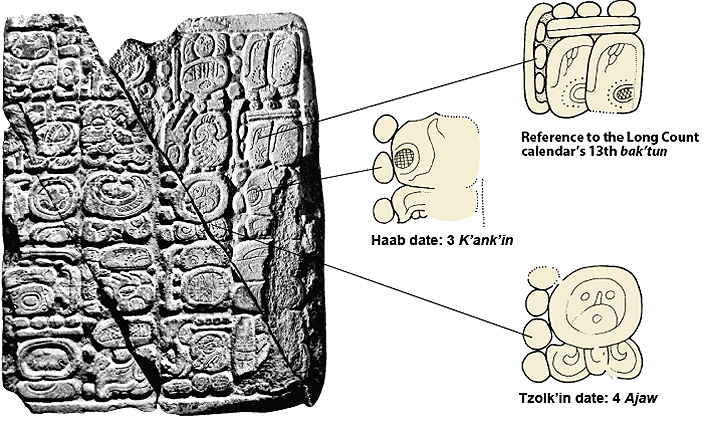
The date 4 Ajaw records the day in the tzolk’in calendar. The tzolk’in is based on a 13-day “week.” The number 4 in the date records the day of the week. There are also 20 named days, so each day has a name and a number. The first named day is Imix, which translates as “water serpent” in Yukatek Mayan, followed by Ik’ (“wind”), and Ak’bal (“night”). The numbers run concurrently with the names, so the first day of the tzolk’in calendar is 1 Imix, followed by 2 Ik’, and then 3 Ak’bal. After day 13 is reached, the numbers start over but the names continue, therefore the fourteenth day of the tzolk’in is called 1 Ix (“jaguar”). This cycle continues for 260 days, when the calendar returns to 1 Imix. The twentieth day name, and the one mentioned in the Tortuguero monument, is Ajaw (“lord”), which was the day when many important festivals commemorating period endings were celebrated.
The date “3 K’ank’in” refers to a day in the haab calendar, which is based on the solar year. Each day in the haab is numbered from zero to 19 and occurs during one of 18 named months called a winal. The first day of the haab is called 0 Pop, the second day is 1 Pop, etc., up to 19 Pop. The twenty-first day of the haab is 0 Wo. The 18 winals add up to 360 days. The remaining five days of the solar year were called Wayeb, and were considered a time of bad luck. The Maya did not include a leap day in the haab calendar, so it would diverge from our modern calendars by one day every four years.
The tzolk’in and haab calendars were also used together in what is called the “Calendar Round.” Starting at 1 Imix 0 Pop, it takes 52 haab years or 73 tzolk’in cycles for the two calendars to come around again to that date. The last calendar round was completed on April 28, 2011. The next one will end on April 15, 2063.
The Calendar Inscriptions
By ZACH ZORICH
Thursday, December 13, 2012
Tortuguero
One of the few artifacts that survived being crushed in the gravel factory that now occupies the site of Tortuguero in southern Mexico is a large stone tablet (monument six) that records important events in the life of the ruler Bahlam Ajaw (“Jaguar Lord”), who lived in the early seventh century a.d. The tablet contains one of only two known references to the end of the thirteenth bak’tun (13.0.0.0.0 4 Ajaw 3 K’ank’in), which translates to December 23, 2012. This is the inscribed date that people refer to when they discuss the Maya calendar predicting the end of time.
Chiapa de Corzo
A small fragment of a monument from the site of Chiapa de Corzo in southern Mexico indicates when the earliest known Long Count date was written. Parts of the inscription have been lost, but based on the readable glyphs, Gareth Lowe of Brigham Young University deduced that it probably recorded a date in 36 B.C.
Tonina
The most recent Long Count date comes from a monument at the city of Tonina in southern Mexico. It commemorates the k’atun that ended on 10.4.0.0.0, which took place in A.D. 909. By that time, Tonina’s power and influence were in decline, but the ruling dynasty seems to have managed to hold on to power longer than many of their neighbors.
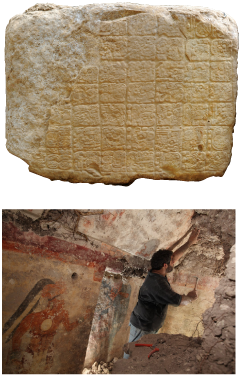 La Corona
La Corona
A stone block from a staircase decorated with hieroglyphics at La Corona, an ancient Maya city in northern Guatemala, was carved to commemorate a visit by the king of the region’s most powerful city, Calakmul, sometime after August 5, A.D. 695, when the king had been defeated by an army from the city of Tikal. According to Marcello Canuto, David Stuart, and Tomás Barrientos of the La Corona Project, the king was probably visiting to shore up support among his allies after his defeat. The glyphs refer to the king as “13 k’atun lord”—the end of the thirteenth k’atun had been celebrated a few years earlier. The text goes on to refer to the end of the thirteenth bak’tun, 13.0.0.0.0 4 Ajaw 3 K’ank’in, perhaps as a way to locate the recent historical events within larger cycles of time.
Xultun
Evidence of the way Maya priests calculated calendar dates was discovered earlier this year at the ancient Maya city of Xultun in northern Guatemala’s Petén rain forest. The investigation of a looter’s trench revealed a building that may have been used as a workshop by priests or scribes. In addition to vibrant paintings of a king and other important figures, numbers were painted and scratched into the building’s plaster walls. According to a group of researchers led by William Saturno of Boston University, the numbers were probably tied to calculating the movements of the moon, Venus, and Mars.
The Maya Codices
By ZACH ZORICH
Thursday, December 13, 2012
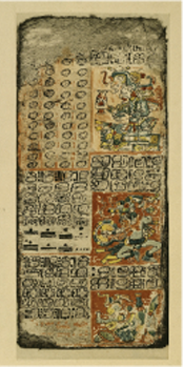 We gather much of what we know about Maya astronomical knowledge from detailed records they themselves created on the pages of bark-paper books called codices. In the mid-sixteenth century, Franciscan missionaries burned nearly all of the Maya’s written records in an effort to eradicate their religion. Today, only three or four Maya codices remain. Three of them are named for the European cities where they are kept—Dresden, Paris, and Madrid. The authenticity of a fourth book called the Grolier Codex, now in Mexico City, is still disputed. The codices were probably written no earlier than the twelfth century A.D., but the Maya may have copied books that were written much earlier. According to archaeoastronomer Anthony Aveni, the codices were used to set dates for rituals, often by linking them to astronomical events.
We gather much of what we know about Maya astronomical knowledge from detailed records they themselves created on the pages of bark-paper books called codices. In the mid-sixteenth century, Franciscan missionaries burned nearly all of the Maya’s written records in an effort to eradicate their religion. Today, only three or four Maya codices remain. Three of them are named for the European cities where they are kept—Dresden, Paris, and Madrid. The authenticity of a fourth book called the Grolier Codex, now in Mexico City, is still disputed. The codices were probably written no earlier than the twelfth century A.D., but the Maya may have copied books that were written much earlier. According to archaeoastronomer Anthony Aveni, the codices were used to set dates for rituals, often by linking them to astronomical events.
The pages of the codices usually depict a deity and include a series of glyphs describing what the deity is doing. Many pages of these books also contain lists of numbers that allowed the Maya to predict lunar and solar eclipses, the phases of the moon, and movements of Mars and Venus. One example is a series of three pages in the Dresden Codex that record the phases of Venus as well as a list of tzolk’in dates and glyphs that have to do with omens and augury. The Maya believed that Venus was associated with violence and bad luck at certain times of the year. That association is clear on the second page in the series, which shows an image of the god Kukulcan, representing Venus, in the process of spearing an enemy.
An Eye on Venus
By ZACH ZORICH
Thursday, December 13, 2012
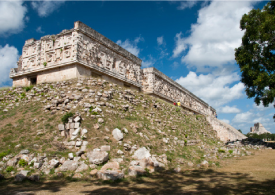 The sun and the moon were not the only celestial bodies of importance to the ancient Maya. The movements of the planet Venus also held special meaning for them. Tables that mark Venus’ position throughout the year are recorded in ancient Maya books called codices and on monuments throughout the Maya kingdoms. Venus also seems to have influenced the architecture of the city Uxmal in the northwestern part of Yucatán, Mexico. Anthony Aveni, an archaeoastronomer at Colgate University, believes that the royal residence named the “House of the Governor” was designed with the observation of Venus in mind. Venus symbols decorate its façade and from its central doorway an observer can still see the planet align with monuments across the site that mark the northern and southern extremes of Venus’ migration along the horizon throughout the year.
The sun and the moon were not the only celestial bodies of importance to the ancient Maya. The movements of the planet Venus also held special meaning for them. Tables that mark Venus’ position throughout the year are recorded in ancient Maya books called codices and on monuments throughout the Maya kingdoms. Venus also seems to have influenced the architecture of the city Uxmal in the northwestern part of Yucatán, Mexico. Anthony Aveni, an archaeoastronomer at Colgate University, believes that the royal residence named the “House of the Governor” was designed with the observation of Venus in mind. Venus symbols decorate its façade and from its central doorway an observer can still see the planet align with monuments across the site that mark the northern and southern extremes of Venus’ migration along the horizon throughout the year.
Venus orbits the sun approximately every 225 days, but as it is seen from Earth, the planet appears to move back and forth relative to the sun in a cycle that lasts 584 days. Five of these oscillations—2,920 days—are almost exactly as long as eight solar years. Aveni believes that Maya priests saw significance in this astronomical coincidence. “For the Maya, everything has to be brought together in terms of whole multiples and that’s where Venus comes in. It has a five-to-eight rhythm with the sun,” says Aveni.
Venus also appears to go through four phases. For 250 days the planet is known in Western cultures as the “Evening Star” as it follows the setting sun. After the Evening Star phase, Venus disappears for eight days before returning as the “Morning Star”—the 236-day-long phase when it rises just before dawn. After the Morning Star phase, Venus disappears for 90 days before returning again as the Evening Star. A document from Central Mexico written in the late 1500s called the Annals of Cuauhtitlan associates the eight-day period between the Evening and Morning Star phases with the death and resurrection of Quetzalcoatl, a deity known as Kukulcan to the ancient Maya. Kukulcan was the sky god and the most powerful of the ancient Maya deities. According to Aveni, rituals celebrating the appearance of the Morning Star may have been held on the large plaza in front of the House of the Governor, providing the rulers of Uxmal with a way to commemorate their ties to the sky god.
The Modern Calendar Priests
Thursday, December 13, 2012
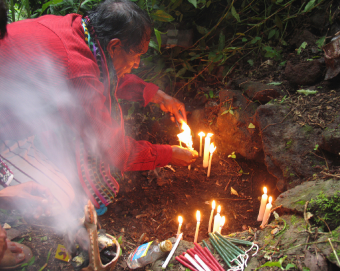 The Long Count calendar may be a relic of the past, but modern-day Maya communities in the highlands of Guatemala still have “Daykeepers,” people whose job it is to maintain a 260-day ritual calendar. Allen Christenson, an anthropologist at Brigham Young University, apprenticed himself to a Daykeeper to gain a better understanding of Maya concepts of time and the cosmos. According to Christenson, the Daykeepers’ role in the community is to keep track of different cycles of time, to perform the proper rituals to keep the cycles running, and to heal people when they are sick. The 260-day calendar they use today is the same as the tzolk’in calendar used by the Maya 1,000 years ago, although the modern calendar is shifted two days later than the ancient one. One concept that seems strange to the Daykeepers with whom Christenson has worked is the idea that some kind of apocalypse is going to happen on December 23, 2012. Until recently the highland Maya had little or no knowledge of the predictions regarding the 2012 date, but that doesn’t mean that they don’t think the world will end. “The world is going die on December 23,” says Christenson, explaining that the Maya believe the world dies each day when the sun sets, or when crops are harvested. “The world is constantly dying,” he says, “and the role of the Daykeeper is to make sure they get things going again.”
The Long Count calendar may be a relic of the past, but modern-day Maya communities in the highlands of Guatemala still have “Daykeepers,” people whose job it is to maintain a 260-day ritual calendar. Allen Christenson, an anthropologist at Brigham Young University, apprenticed himself to a Daykeeper to gain a better understanding of Maya concepts of time and the cosmos. According to Christenson, the Daykeepers’ role in the community is to keep track of different cycles of time, to perform the proper rituals to keep the cycles running, and to heal people when they are sick. The 260-day calendar they use today is the same as the tzolk’in calendar used by the Maya 1,000 years ago, although the modern calendar is shifted two days later than the ancient one. One concept that seems strange to the Daykeepers with whom Christenson has worked is the idea that some kind of apocalypse is going to happen on December 23, 2012. Until recently the highland Maya had little or no knowledge of the predictions regarding the 2012 date, but that doesn’t mean that they don’t think the world will end. “The world is going die on December 23,” says Christenson, explaining that the Maya believe the world dies each day when the sun sets, or when crops are harvested. “The world is constantly dying,” he says, “and the role of the Daykeeper is to make sure they get things going again.”
Advertisement
Advertisement
IN THIS ISSUE
Advertisement

Recent Issues
-
 May/June 2024
May/June 2024
-
 March/April 2024
March/April 2024
-
 January/February 2024
January/February 2024
-
 November/December 2023
November/December 2023
-
 September/October 2023
September/October 2023
-
 July/August 2023
July/August 2023
-
 May/June 2023
May/June 2023
-
 March/April 2023
March/April 2023
-
 January/February 2023
January/February 2023
-
 November/December 2022
November/December 2022
-
 September/October 2022
September/October 2022
-
 July/August 2022
July/August 2022
-
 May/June 2022
May/June 2022
-
 March/April 2022
March/April 2022
-
 January/February 2022
January/February 2022
-
 November/December 2021
November/December 2021
-
 September/October 2021
September/October 2021
-
 July/August 2021
July/August 2021
-
 May/June 2021
May/June 2021
-
 March/April 2021
March/April 2021
-
 January/February 2021
January/February 2021
-
 November/December 2020
November/December 2020
-
 September/October 2020
September/October 2020
-
 July/August 2020
July/August 2020
-
 May/June 2020
May/June 2020
-
 March/April 2020
March/April 2020
-
 January/February 2020
January/February 2020
-
 November/December 2019
November/December 2019
-
 September/October 2019
September/October 2019
-
 July/August 2019
July/August 2019
-
 May/June 2019
May/June 2019
-
 March/April 2019
March/April 2019
-
 January/February 2019
January/February 2019
-
 November/December 2018
November/December 2018
-
 September/October 2018
September/October 2018
-
 July/August 2018
July/August 2018
-
 May/June 2018
May/June 2018
-
 March/April 2018
March/April 2018
-
 January/February 2018
January/February 2018
-
 November/December 2017
November/December 2017
-
 September/October 2017
September/October 2017
-
 July/August 2017
July/August 2017
-
 May/June 2017
May/June 2017
-
 March/April 2017
March/April 2017
-
 January/February 2017
January/February 2017
-
 November/December 2016
November/December 2016
-
 September/October 2016
September/October 2016
-
 July/August 2016
July/August 2016
-
 May/June 2016
May/June 2016
-
 March/April 2016
March/April 2016
-
 January/February 2016
January/February 2016
-
 November/December 2015
November/December 2015
-
 September/October 2015
September/October 2015
-
 July/August 2015
July/August 2015
-
 May/June 2015
May/June 2015
-
 March/April 2015
March/April 2015
-
 January/February 2015
January/February 2015
-
 November/December 2014
November/December 2014
-
 September/October 2014
September/October 2014
-
 July/August 2014
July/August 2014
-
 May/June 2014
May/June 2014
-
 March/April 2014
March/April 2014
-
 January/February 2014
January/February 2014
-
 November/December 2013
November/December 2013
-
 September/October 2013
September/October 2013
-
 July/August 2013
July/August 2013
-
 May/June 2013
May/June 2013
-
 March/April 2013
March/April 2013
-
 January/February 2013
January/February 2013
-
 November/December 2012
November/December 2012
-
 September/October 2012
September/October 2012
-
 July/August 2012
July/August 2012
-
 May/June 2012
May/June 2012
-
 March/April 2012
March/April 2012
-
 January/February 2012
January/February 2012
-
 November/December 2011
November/December 2011
-
 September/October 2011
September/October 2011
-
 July/August 2011
July/August 2011
-
 May/June 2011
May/June 2011
-
 March/April 2011
March/April 2011
-
 January/February 2011
January/February 2011
Advertisement






